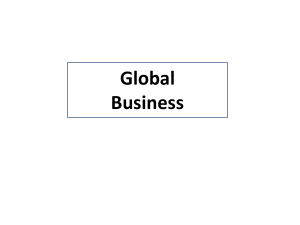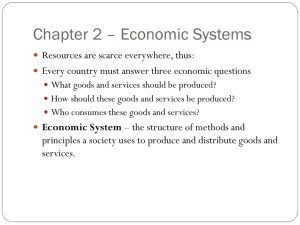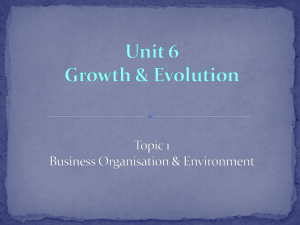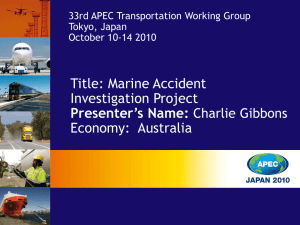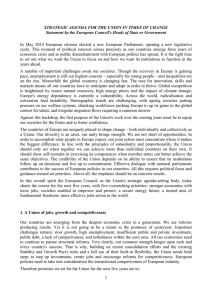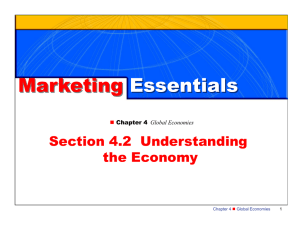Michael Turner - APFF Credit Bureau Workstream
advertisement
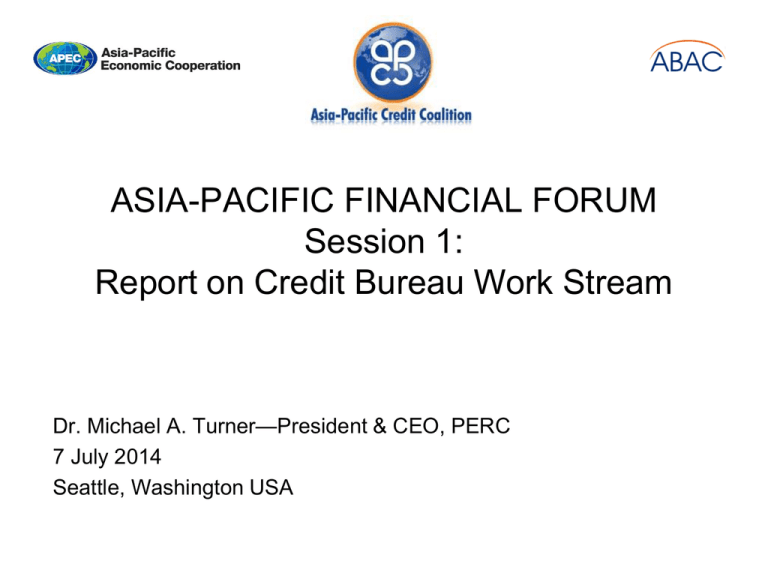
ASIA-PACIFIC FINANCIAL FORUM Session 1: Report on Credit Bureau Work Stream Dr. Michael A. Turner—President & CEO, PERC 7 July 2014 Seattle, Washington USA • Broad consensus around full-file, comprehensive reporting with strong private credit bureau. – World Bank General Principles for Credit Reporting (2011) • IFC, CGAP, global group of experts – OECD Fair Information Principles (1973) – Endorsed by advocacy groups: • Accion FI 20/20 • Alliance for Financial Inclusion • Asia Pacific Credit Coalition (APCC) • BUT still variance in reporting regimes across APEC 21 member economies. Credit Bureau Development • Assist in reform process to catalyze credit bureau development by targeting economies that are clustered in terms of the regulatory gaps and hurdles they face • Proposed Work Plan: – Gap analysis: review of regulations in potential pathfinder economies along key aspects of credit bureau regulation – Identify strategic policymakers with authority over issues – Collaborate with stakeholders to discuss regulatory frameworks Issues identified during Gap Analysis (I) • Some economies are in the process of developing models of regulatory enforcement. – The number of models they are examining may be too few, leaving approaches that are not calibrated to capacity and local needs. – These economies need assistance in developing models of regulatory enforcement. – There is an absence of resource material that help provide a comprehensive set of models for regulatory enforcement Focus of workstream (I) • Regulatory enforcement: – Provide different models of regulatory enforcement from different economies; – Help calibrate models to regulator capacities. Issues identified during Gap Analysis (II) • Regulations for ownership – While there have been caps in some economies on foreign ownership, there have been few guidelines on ownership models that can cause conflicts of interest, such as data user ownership. – In some economies, the rule for core functions such as mandatory reporting and scoring are different for public registries and private bureaus, raising questions of competitive effects. Focus of Work Stream (II) • Ownership: – Identify effects of different ownership forms on competition, financial access and responsible lending; – Provide a comprehensive list of variations in ownership regulation beyond public-private, foreigndomestics. PERC Study #1 • We engaged bureaus, regulators and industry experts in 23 economies – (2 in Africa, 4 in East Asia, 8 in Europe, 8 in Latin America, and 1 in South Asia). • Surveying for commonalities and differences among nations in: – Enforcement regimes and ownership structures • Europe and Latin America have longer histories with credit reporting than do Asia or Africa. • More than half of the economies we examined are emerging ones. Frequency of Government Audits 0% 5% Weekly 10% 15% 20% 5% 3-4 Times per year 5% 1-2 Times per year 5% Yearly Other 30% 35% 40% 9% Monthly Less than Yearly 25% 23% 18% 36% Auditor by Domain Execution of Oversight Efficacy of Audits on Performance 45% 39% 40% 35% 30% 26% 25% 22% 20% 15% 13% 10% 5% 0% Very effective Moderately effective Mildly effective Not effective at all Ownership Structures Case of Mexico: COFECE Recommendations 1. Define property rights clearly such that an anonymous database can be used for research and value added services 2. Set stronger penalties against misuse of CRA data 3. Incorporate private and public credit services providers and public sector utilities still outside the system 4. Set standards to improve the quality, homogeneity and completeness of credit histories 5. Vertical separation between CRAs and users 6. Adopt a sharing or interconnection regulation more conducive to entry by new CRAs 14 PERC Study #2 • We examined 45 countries that implemented full file credit reporting between 1999 and 2011 – World Bank Doing Business – BankScope – Levine, Berth, and Caprio (180 countries) – World Development Indicators – Credit Reporting Database (195 countries) – Global Financial Development Database (203 countries) Financial Market Impacts: Increased Competition Conclusions 1. Evidence does not support one-size fits all approach 2. Issue of ownership structure looms large (Brazil vs. Mexico). 3. Wide variance in enforcement regimes with solid impact on efficiency of credit bureaus. 4. Impacts analysis by APCC/PERC forthcoming. 5. Path finders—engaged Indonesia (full-file and enforcement), Philippines (ownership—PCR mandatory and private only voluntary) and Mexico (ownership) in terms of reform. 6. Real questions remain for these and other APEC member economies. 17




